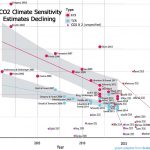Here are two of several, which you guys have dismissed before, and you will again,
You guys are deniers of science. If it doesn't fit your dogma, you find reason to deny it.
Abstract:
We present an advanced two-layer climate model, especially appropriate to calculate the
influence of an increasing CO2-concentration and a varying solar activity on global warming.
The model describes the atmosphere and the ground as two layers acting simultaneously as
absorbers and Planck radiators, and it includes additional heat transfer between these layers due
to convection and evaporation. The model considers all relevant feedback processes caused by
changes of water vapour, lapse-rate, surface albedo or convection and evaporation. In particular,
the influence of clouds with a thermally or solar induced feedback is investigated in some detail.
The short- and long-wave absorptivities of the most important greenhouse gases water vapour,
carbon dioxide, methane and ozone are derived from line-by-line calculations based on the
HITRAN08-databasis and are integrated in the model. Simulations including an increased solar
activity over the last century give a CO2 initiated warming of 0.2 °C and a solar influence of
0.54 °C over this period, corresponding to a CO2 climate sensitivity of 0.6 °C (doubling of CO2)
and a solar sensitivity of 0.5 °C (0.1 % increase of the solar constant).
(PDF) Advanced Two-Layer Climate Model for the Assessment of Global Warming by CO2
Abstract:
We present detailed line-by-line radiation transfer calculations, which were performed under different atmospheric conditions for the most important greenhouse gases water vapor, carbon dioxide, methane, and ozone. Particularly cloud effects, surface temperature variations, and humidity changes as well as molecular lineshape effects are investigated to examine their specific influence on some basic climatologic parameters like the radiative forcing, the long wave absorptivity, and back-radiation as a function of an increasing CO2 concentration in the atmosphere. These calculations are used to assess the CO2 global warming by means of an advanced two-layer climate model and to disclose some larger discrepancies in calculating the climate sensitivity. Including solar and cloud effects as well as all relevant feedback processes our simulations give an equilibrium climate sensitivity of = 0.7°C (temperature increase at doubled CO2) and a solar sensitivity of = 0.17°C (at 0.1% increase of the total solar irradiance). Then CO2 contributes 40% and the Sun 60% to global warming over the last century.
https://www.hindawi.com/journals/ijas/2017/9251034/
 [h=2]Recent CO2 Climate Sensitivity Estimates Continue Trending Towards Zero[/h]By Kenneth Richard on 16. October 2017
[h=2]Recent CO2 Climate Sensitivity Estimates Continue Trending Towards Zero[/h]By Kenneth Richard on 16. October 2017